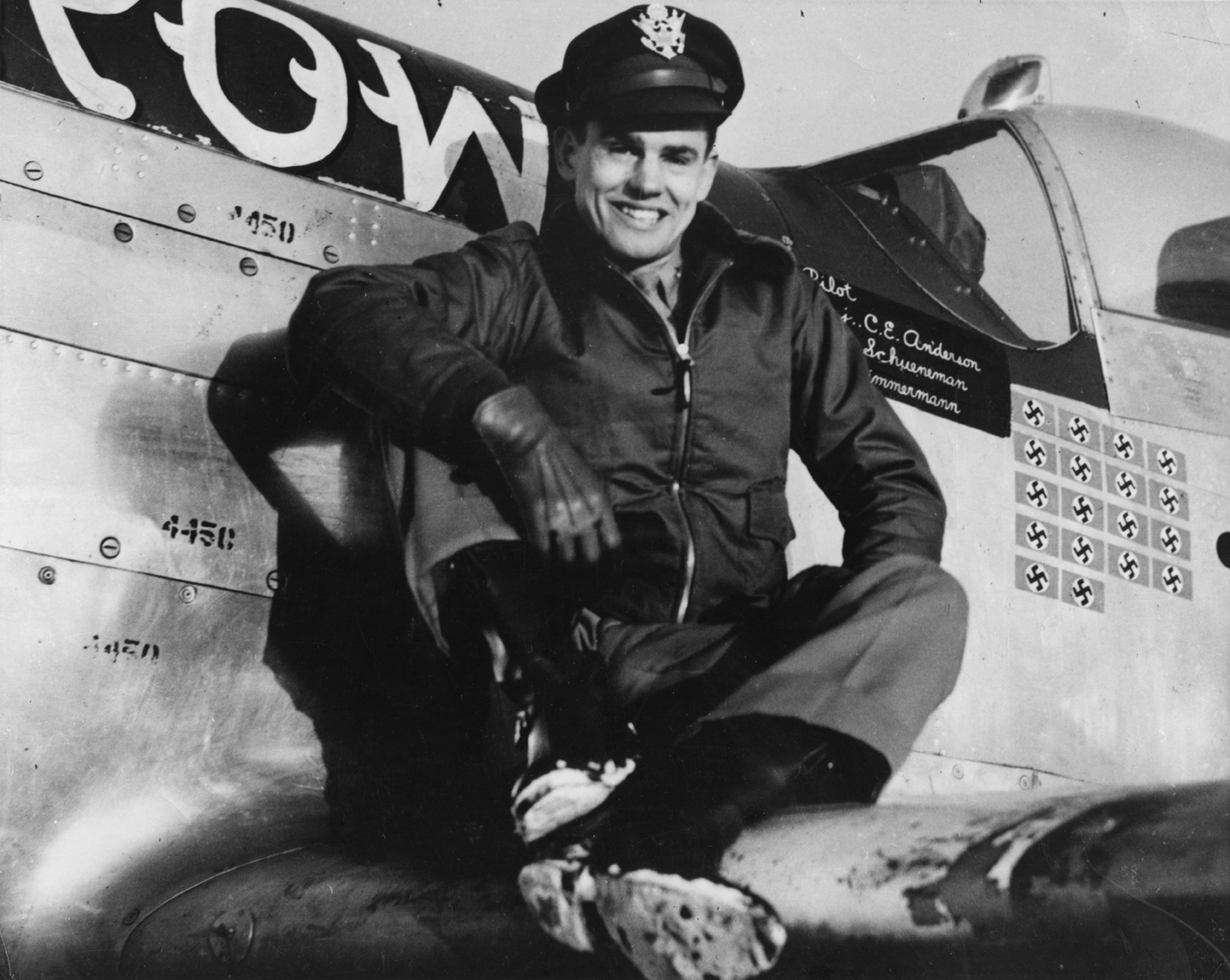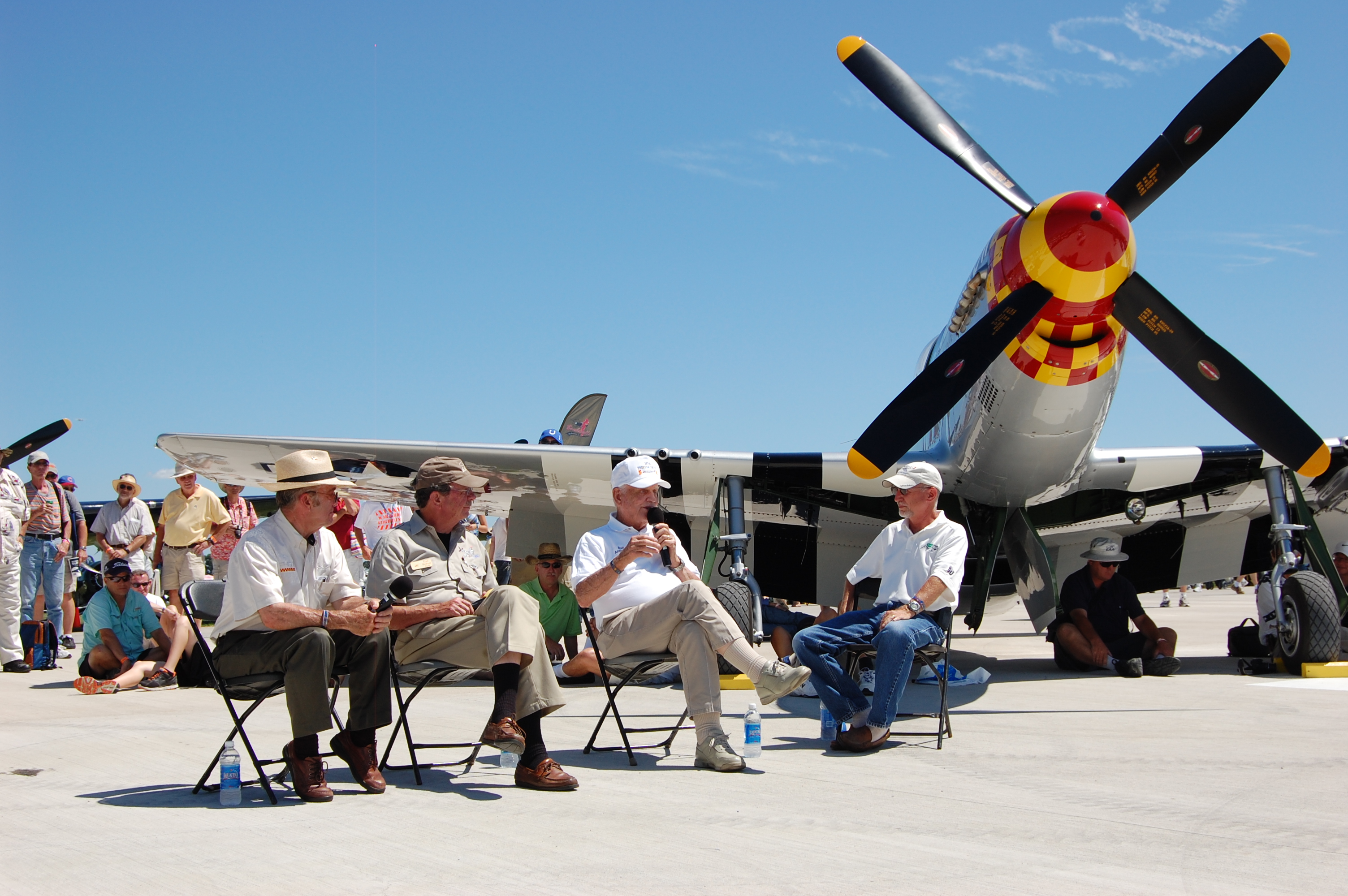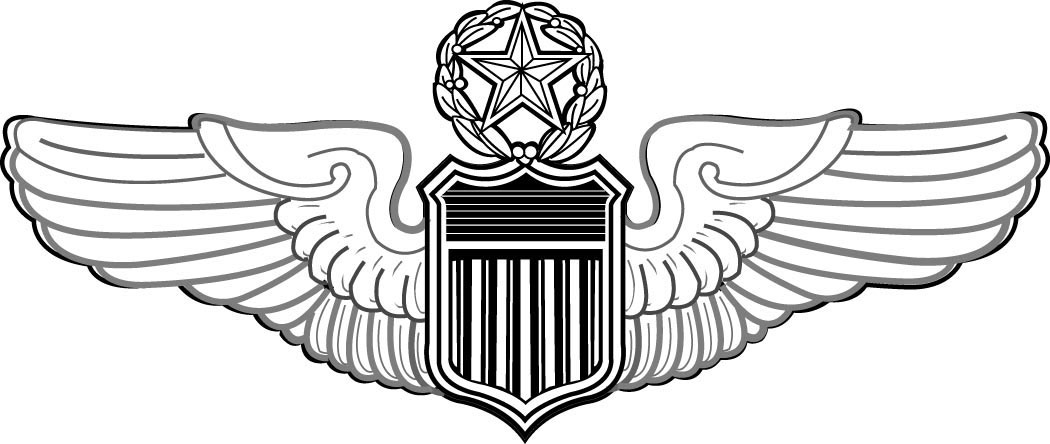1. Overview
Clarence Emil "Bud" Anderson (January 13, 1922 - May 17, 2024) was a distinguished officer in the United States Air Force and a renowned triple ace of World War II. He achieved the highest number of aerial victories in his P-51 Mustang squadron during the war. Anderson's military career spanned multiple conflicts, including the Korean War and the Vietnam War, where he served as a test pilot, fighter squadron commander, and wing commander. After retiring as a full colonel in 1972, he continued his contributions to aviation in flight test management for McDonnell Douglas. A member of the National Aviation Hall of Fame, Anderson remained an active and popular speaker at aviation and military events well into his 90s, receiving an honorary promotion to brigadier general in 2022 in recognition of his lifetime achievements. He was the last living American triple flying ace of World War II.
2. Early life
Clarence Emil Anderson was born on January 13, 1922, in Oakland, California, and spent his formative years on a farm near Newcastle, California. He attended Placer Union High School in Auburn, California, where he was active in both football and basketball. His initial exposure to aviation occurred at Oakland Municipal Airport. At the time of the attack on Pearl Harbor by Japan on December 7, 1941, Anderson was working at the Sacramento Air Depot.
3. Military career
Anderson's extensive military service began in January 1942, shortly after the attack on Pearl Harbor, when he enlisted in the United States Army as an aviation cadet.
3.1. World War II
Anderson's combat experience during World War II established his reputation as a formidable fighter pilot.
3.1.1. Training and deployment
He completed his Primary Flight Training at Lindbergh Field in San Diego, followed by Advanced Training at Luke Field in Arizona. In September 1942, he earned his wings and received his commission as a second lieutenant in the United States Army Air Forces at Hamilton Field, California.
From September 1942 to March 1943, Anderson began flying Bell P-39 Airacobras with the 329th Fighter Squadron of the 328th Fighter Group, initially at Hamilton Field and then at the Oakland Municipal Airport. In March 1943, he was assigned to the 363rd Fighter Squadron, part of the 357th Fighter Group, at Tonopah, Nevada. His unit subsequently moved through various bases in California from May to October 1943, then to Casper, Wyoming, from October to November 1943, before finally deploying to England in November 1943.
3.1.2. Service with the 357th Fighter Group
The 357th Fighter Group, also known as the "Yoxford Boys," was stationed at RAF Leiston in England. In January 1944, the group was equipped with the North American P-51 Mustang. Anderson's first aerial victory occurred on February 5, 1944, when he damaged a Messerschmitt Bf 109 that was attacking a straggling B-17 Flying Fortress north of Dessau, Germany.
3.1.3. Aircraft and missions
Anderson flew two combat tours against the Luftwaffe in Europe with the 363rd Fighter Squadron, based at RAF Leiston. He primarily flew P-51 Mustangs, with his first (P-51B-15-NA AAF Ser. No. 43-24823) and second (P-51D-10-NA Mustang, AAF Ser. No. 44-14450 B6-S) aircraft both famously nicknamed Old Crow. This name was inspired by the whiskey of the same name. Remarkably, Anderson completed 116 combat missions in his "Old Crow" Mustangs without ever being hit by enemy fire or having to turn back for any reason.

3.1.4. Combat record and aerial victories
On April 11, 1944, Anderson claimed another Bf 109 west of Hanover and damaged a second 20 minutes later. During the same mission, he and two other pilots from his flight collaboratively shot down a Heinkel He 111 bomber that was attempting to land at an airfield in Hanover, resulting in a shared aerial victory credit for the three pilots. Anderson continued to achieve aerial victories, officially becoming a flying ace on May 12, 1944, after shooting down a Bf 109 over Frankfurt, Germany, marking his fifth aerial victory. By the end of May, he had destroyed three more enemy aircraft.
On June 29, Anderson led his fighter squadron on a bomber escort mission over Leipzig, Germany. Over the target, the squadron encountered eight Focke-Wulf Fw 190s attempting to attack the bomber formation. Anderson shot down the lead Fw 190 and then, in the ensuing dogfight, downed two more Fw 190s, bringing his total for that mission to three. In July, after achieving his twelfth aerial victory, he took leave and returned to the United States.

That fall, Anderson returned to the 357th Fighter Group. On November 27, he shot down two Fw 190s over Magdeburg, Germany, and forced another to crash-land as he attempted to shoot it down, earning him credit for two aerial victories and one probable. On December 5, while leading a fighter escort for bombers over Berlin, Germany, his escort was attacked by a formation of 20 Fw 190s. In the ensuing dogfight, he shot down two, which became his final aerial victories of the war.
Anderson was the 357th Fighter Group's third leading ace, credited with 16.25 aerial victories. He was promoted to major at the age of 22, a remarkably young age for such a high rank during wartime. During World War II, Anderson became a close friend of Chuck Yeager, who also served in the 357th Fighter Group and later became a brigadier general.
3.2. Post-war Service
After World War II, Anderson continued his distinguished military career, transitioning into roles as a test pilot and commander.
3.2.1. Test pilot duties
Anderson returned to the U.S. in January 1945, serving at Perrin Field, Texas, until October of that year, when he was assigned as a recruiter in Ohio. In May 1948, he transitioned to a test pilot role at Wright Field, serving there until February 1953. During this period, he participated in the FICON project, an experimental concept designed to extend the combat radius of jet fighters by attaching them to the wingtips of a propeller-driven bomber. The project aimed not only to increase fuel efficiency and effective range but also to allow the bomber to carry its own fighter escort deep into enemy territory.

He continued his test pilot duties, serving as Assistant Chief and then Chief of the Flight Test Operations Division at Edwards Air Force Base from November 1957 to August 1962. From July 1963 to August 1965, he served as Deputy Chief of Flight Test and Deputy Chief of System Test at Edwards Air Force Base.
3.2.2. Command assignments
Anderson attended Air Command and Staff College at Maxwell Air Force Base, Alabama, from September 1954 to August 1955. Following this, he was assigned as Director of Operations for the 58th Fighter-Bomber Wing at Osan Air Base, South Korea, from August 1955 to February 1956. He then commanded the 69th Fighter-Bomber Squadron at Osan from February to August 1956. From August 1956 to November 1957, he served as the Senior Officer of the 6511th Test Wing stationed at Naval Air Facility El Centro, California.
He attended the Army War College at Carlisle Barracks, Pennsylvania, from August 1962 to July 1963. From August 1965 to December 1967, he was stationed at Kadena Air Base in Okinawa, where he served as deputy director, director of operations, and commander of the 18th Tactical Fighter Wing.
3.3. Vietnam War
After serving another tour at the Air Force headquarters in The Pentagon until December 1969, Anderson commanded the 355th Tactical Fighter Wing, an F-105 Thunderchief unit, during its final months of service in the Vietnam War, from June to December 1970. Stationed at Takhli Royal Thai Air Force Base, he flew 25 missions conducting strikes against enemy supply lines. Following the inactivation of the 355th Tactical Fighter Wing, he was responsible for closing the base.
Anderson retired as a colonel in March 1972, concluding nearly three decades of service. Throughout his career, he was decorated 25 times for his contributions to the United States, having flown over 100 types of aircraft and logging more than 7,000 hours in the air.
4. Civilian career
Following his distinguished military career, Clarence "Bud" Anderson transitioned to a significant role in the civilian aviation sector.
4.1. Work at McDonnell Douglas
After his retirement from active duty as a colonel, Anderson became the manager of the McDonnell Aircraft Company's Flight Test Facility at Edwards Air Force Base. He held this position until 1998, continuing his involvement in cutting-edge aviation technology.
5. Personal life and death
Anderson's personal life was marked by a long marriage and continued engagement with the aviation community into his later years.
5.1. Marriage and family
Anderson married Eleanor Cosby on February 23, 1945. They had two children. Eleanor passed away on January 30, 2015, in Auburn, California, just four days before her 92nd birthday, and is interred at Arlington National Cemetery.
5.2. Later life and public activities
In 1990, Anderson co-wrote his memoir, To Fly & Fight-Memoirs of a Triple Ace, with Joseph P. Hamelin. He also appeared in the pilot episode of the History Channel series Dogfights in 2005. The episode, titled 'The Greatest Air Battles,' featured his May 27, 1944, mission, with Anderson himself recounting his experiences.

Anderson remained actively engaged with the aviation community, frequently speaking at military and aviation events well into his 90s and 100s. He was recognized as the last living American triple flying ace of World War II. In January 2022, he celebrated his 100th birthday, with his hometown of Auburn, California, honoring him with a grand celebration.
6. Death
Clarence "Bud" Anderson died peacefully in his sleep at his home in Auburn, California, on May 17, 2024, at the age of 102. Approximately three months after his passing, a life-size bronze statue of Anderson, depicted in his leather flight helmet and goggles and wearing a parachute, was installed in Grass Valley, California.
7. Awards and Decorations
Anderson received numerous military awards and decorations throughout his nearly 30-year career, including:

Command pilot wings - Legion of Merit with one bronze oak leaf cluster (indicating two awards)
- Distinguished Flying Cross with four bronze oak leaf clusters (indicating five awards)
- Bronze Star Medal
- Air Medal with three silver oak leaf clusters (indicating sixteen awards)
- Air Force Commendation Medal
- Air Force Presidential Unit Citation
- Air Force Outstanding Unit Award
- American Campaign Medal
- European-African-Middle Eastern Campaign Medal with four bronze service stars
- World War II Victory Medal
- National Defense Service Medal with one bronze service star
- Vietnam Service Medal with two bronze service stars (indicating three awards)
- Korea Defense Service Medal
- Air Force Longevity Service Award with one silver and one bronze oak leaf clusters (indicating seven awards)
- Small Arms Expert Marksmanship Ribbon
- Knight of the Legion of Honour (France)
- Croix de Guerre with silver star (France)
- Vietnam Gallantry Cross Unit Award with palm (South Vietnam)
- Vietnam Campaign Medal with 1960- device (South Vietnam)
He was also a life member of the American Fighter Aces Association and a Fellow of the Society of Experimental Test Pilots.
8. Legacy and Recognition
Anderson's distinguished service and contributions to aviation were widely recognized through various honors and tributes.
8.1. Hall of Fame inductions
In 1993, Anderson was inducted into the Aerospace Walk of Honor. He was inducted into the National Aviation Hall of Fame on July 19, 2008. In 2013, he was further honored with induction into the International Air & Space Hall of Fame at the San Diego Air & Space Museum.
8.2. Memorials and tributes
A life-size bronze statue of Clarence "Bud" Anderson was installed at the Auburn Municipal Airport in his hometown. Following his death, another life-sized bronze statue was installed in Grass Valley, California. In May 2015, Anderson, along with other flying aces, was awarded the Congressional Gold Medal in recognition of "their heroic military service and defense of the country's freedom throughout the history of aviation warfare."
8.3. Publications and media appearances
Anderson' co-authored memoir, To Fly & Fight-Memoirs of a Triple Ace, chronicles his experiences. His appearance on the History Channel's Dogfights series further brought his combat experiences to a wider audience.
8.4. Honorary promotion
On December 2, 2022, at the age of 100, Anderson received an honorary promotion to the rank of brigadier general. This promotion was administered by General Charles Q. Brown Jr., the Chief of Staff of the United States Air Force, during a ceremony at the Aerospace Museum of California.
9. Aerial victory credits
The following table details Clarence "Bud" Anderson's confirmed aerial combat victories during World War II:
| Date | # | Type | Location | Aircraft flown | Unit Assigned |
|---|---|---|---|---|---|
| March 8, 1944 | 1 | Messerschmitt Bf 109 | Hanover, Germany | P-51B | 363 FS, 357 FG |
| April 11, 1944 | 1 | Bf 109 | Hanover, Germany | P-51B | 363 FS, 357 FG |
| 0.20 | Heinkel He 111 | Hanover, Germany | P-51B | 363 FS, 357 FG | |
| April 30, 1944 | 1 | Focke-Wulf Fw 190 | Orléans, France | P-51B | 363 FS, 357 FG |
| May 8, 1944 | 1 | Fw 190 | Soltau, Germany | P-51B | 363 FS, 357 FG |
| May 12, 1944 | 1 | Bf 109 | Frankfurt, Germany | P-51B | 363 FS, 357 FG |
| May 27, 1944 | 2 | Bf 109 | Strasbourg, France | P-51B | 363 FS, 357 FG |
| May 30, 1944 | 1 | Bf 109 | Schönebeck, Germany | P-51B | 363 FS, 357 FG |
| June 29, 1944 | 3 | Fw 190 | Leipzig, Germany | P-51B | 363 FS, 357 FG |
| July 7, 1944 | 1 | Bf 109 | Leipzig, Germany | P-51B | 363 FS, 357 FG |
| November 27, 1944 | 2 | Fw 190 | Magdeburg, Germany | P-51D | 363 FS, 357 FG |
| December 5, 1944 | 2 | Fw 190 | Berlin, Germany | P-51D | 363 FS, 357 FG |